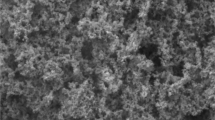Abstract
The hydration properties of slag sulfate cement (SSC), slag Portland cement (PSC), and ordinary Portland cement (POC) were compared in this study by determining the compressive strength of pastes, the hydration heat of binders within 72 h, the pore structure, the hydration products, and the hydration degree. The results indicated that main hydration products of PSC paste and POC paste are calcium hydroxide and C–S–H gel, while those of SSC paste are ettringite and C–S–H gel from the analyses of XRD, TG–DTA, and SEM. At the early curing age, the compressive strength depends on the clinker content in the cementitious system, while at the late curing age, which is related to the potential reactivity of slag. From hydration heat analysis, the cumulative hydration heat of PSC is lower than that of POC, but higher than that of SSC. Slag can limit chemical reaction and the delayed coagulation of gypsum, which also plays a role in the early hydration. So SSC shows the lowest heat release and slag can’t be simulated without a suitable alkaline solution. Based on MIP analysis, the porosity of POC paste is the smallest while the average pore size is the biggest. At the age of 90 days, the compressive strength of SSC can get higher development because of its relative smaller pore size than that of PSC and POC paste.













Similar content being viewed by others
References
Liu SH, Kong YN, Wang L. A comparison of hydration properties of cement–low quality fly ash binder and cement–limestone powder binder. J Therm Anal Calorim. 2014;116(2):937–43.
Smokzyk HG. Slag structure and identification of slag. Principal Report. In: 7th International Congress on Cement, Paris;1980. p. 1–17.
Liu SH, Li LH. Influence of fineness on the cementitious properties of steel slag. J Therm Anal Calorim. 2014;117(2):629–34.
Miyairi H, Furukawa R, Sato K. The influence of chemical composition of granulated blastfurnace slag and Portland cement clinker of various Portland cements on resistance to seawater. CAJ Rev., 29th Gen. Meeting; p. 73–85.
Reeves CM. The use of ground granulated blastfurnace slag to produce durable concrete. Durability of Concrete Conference. London: Inst. Civ. Engrs.,; May 1985. p. 37–54.
Jia YD, A R H, Yan PY. Natural and accelerated carbonation of concrete containing fly ash and GGBS after different initial curing period. Mag Concr Res. 2011;64(2):143–50.
Worrell E, Price L, Martin N, et al. Carbon dioxide emissions from the global cement industry. Annu Rev Energy Environ. 2001;26(2):303–29.
Mehta PK. Reducing the environmental impact of concrete. Concr Int. 2001;23(1):61–6.
Wainwright PJ and Tolloczko JJ. The early and later age properties of temperature cycles OPC concrete. 2th Int.Conf. on the Use of Fly Ash, Silica Fume, Slag and Natural Pozzolans in concrete, Madrid, CANMET; April 1986. p. 1063–81.
Purdon AO. The action of alkalis on blast-furnace slag. J Chem Soc Ind. 1940;59(1):191–202.
Bernal Susan A, John L, et al. Evolution of binder structure in sodium silicate-activated slag-metakaolin blends. Cem Concr Compos. 2011;33(1):46–54.
Shi C, Krivenko PV, Roy DM. Alkali-activated cements and concretes. Abingdon: Taylor and Francis; 2006.
Gruskovnjak A, Lothenbach B, Winnefeld F, et al. Hydration mechanisms of sulphated slag cement. Cem Concr Res. 2008;38(7):983–92.
Juenger MCG, Winnefeld F, Provis JL, et al. Advances in alternative cementitious binders. Cem Concr Res. 2011;41(12):1232–43.
Salao E, Nikaido Y, Itoh T, et al. Ettringite formation and microstructure of rapid hardening cement. Cem Concr Res. 2004;34(8):1669–73.
Mehta PK, Monteiro PJ. Concrete: microstructure, properties, and materials. London: McGraw-Hill; 2006.
Yan PY, Mi GD, Wang Q. A comparison of early hydration properties of cement-steel slag binder and cement-limestone powder binder. J Therm Anal Calorim. 2014;115(1):193–200.
Beushausen H, Alexander M, Ballim Y. Early-age properties, strength development and heat of hydration of concrete containing various South African slags at different replacement ratios. Constr Build Mater. 2012;29(3):533–40.
Kolani B, Buffo-Lacarrière L, Sellier A, et al. Hydration of slag-blended cements. Cem Concr Compos. 2012;34(9):1009–18.
Zhang YS, Xu WQ, Liu QW. The influence of slag on the cement performance. Sci Technol Eng. 2010;34(10):8620–1.
Wang Q, Yang JW, Yan PY. Influence of initial alkalinity on the hydration of steel slag. Sci China (Technol Ed). 2012;55(12):3378–87.
Hou WM, Chang PK, Hwang CL. A study on anticorrosion effect in high-performance concrete by the pozzolanic reaction of slag. Cem Concr Res. 2004;34(4):615–22.
Moisés F, Rojas MIS, Santamaría J, et al. Recycling of silicomanganese slag as pozzolanic material in Portland cements: basic and engineering properties. Cem Concr Res. 2006;36(3):487–91.
Neville AM. Properties of concrete. 4th ed. Essex: Pearson Prentice Hall; 2003. p. 504–505.
Acknowledgements
This Project is funded by the National Natural Science Foundation of China (51208391) and the Opening Funds of State Key Laboratory of Silicate Building Materials (SYSJJ2012-11).
Author information
Authors and Affiliations
Corresponding author
Rights and permissions
About this article
Cite this article
Liu, S., Wang, L., Gao, Y. et al. Comparing study on hydration properties of various cementitious systems. J Therm Anal Calorim 118, 1483–1492 (2014). https://doi.org/10.1007/s10973-014-4052-4
Received:
Accepted:
Published:
Issue Date:
DOI: https://doi.org/10.1007/s10973-014-4052-4




